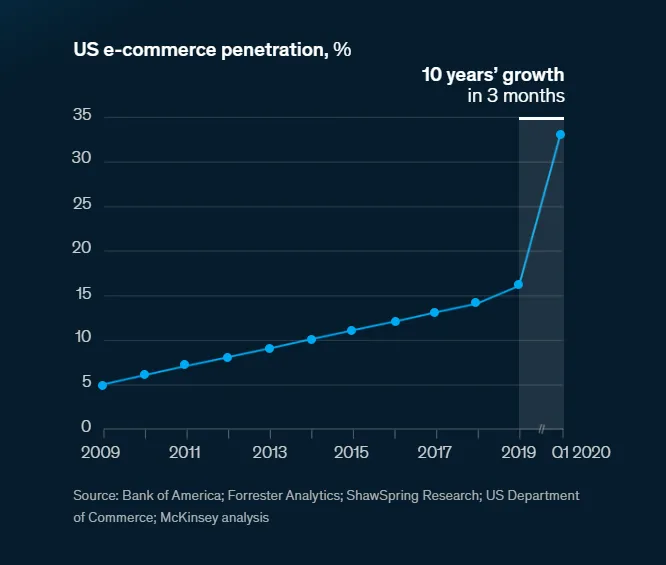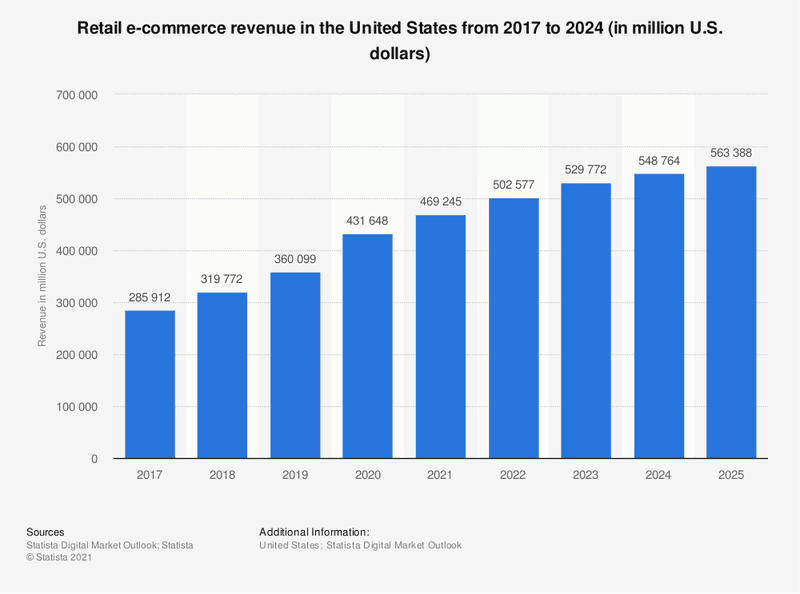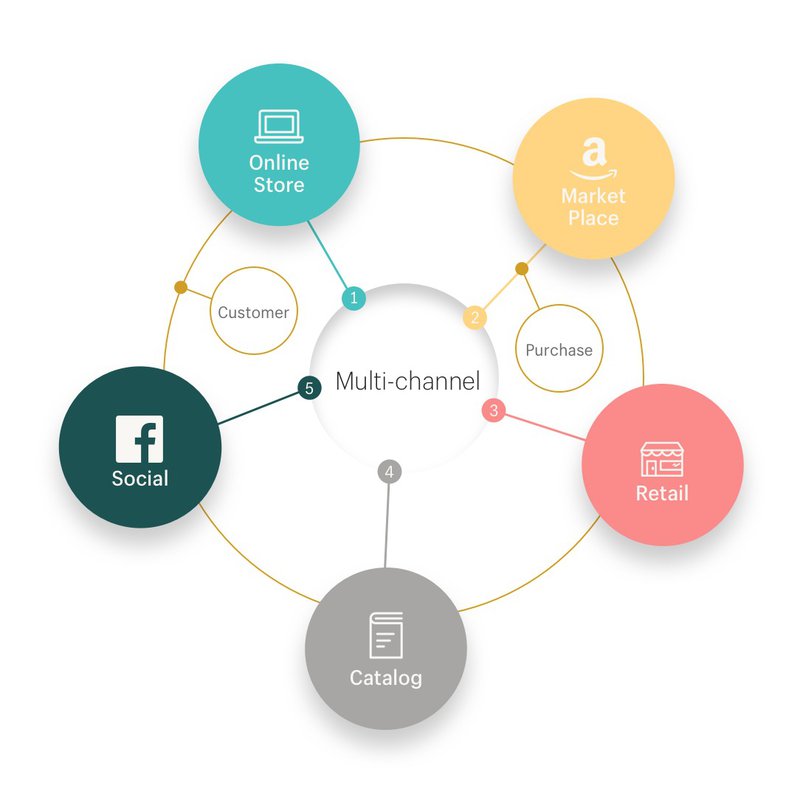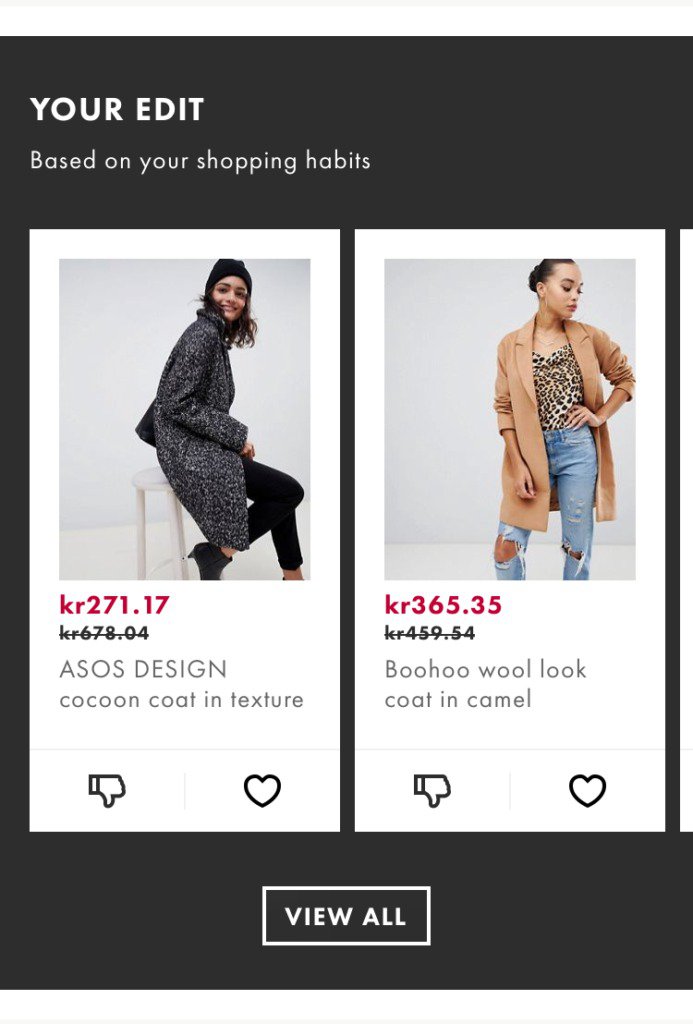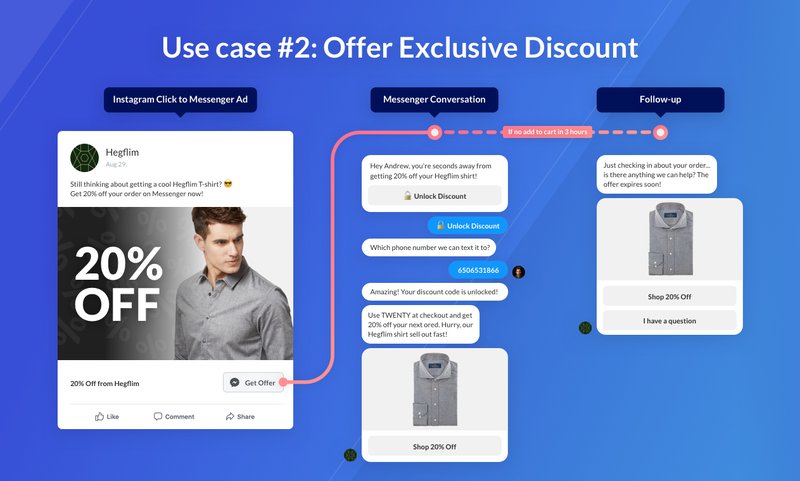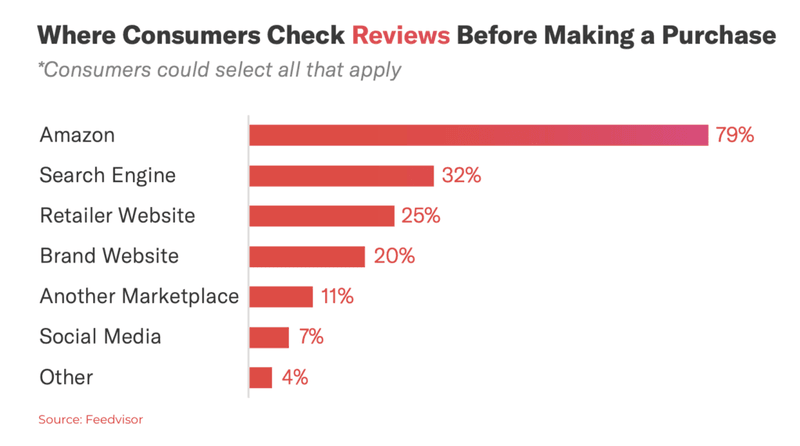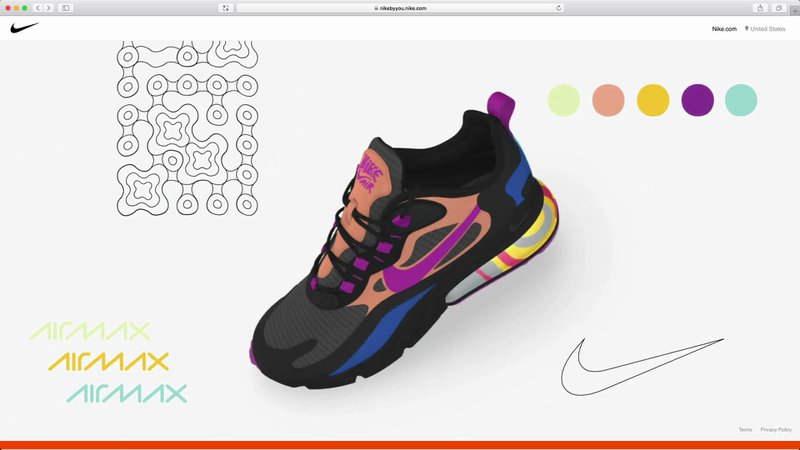What is eCommerce? Everything You Need to Know
Ecommerce has drastically changed the way we source, shop, and use products. Let’s dive into the history and future of eCommerce and how you can scale your brand.
Updated November 6, 2024
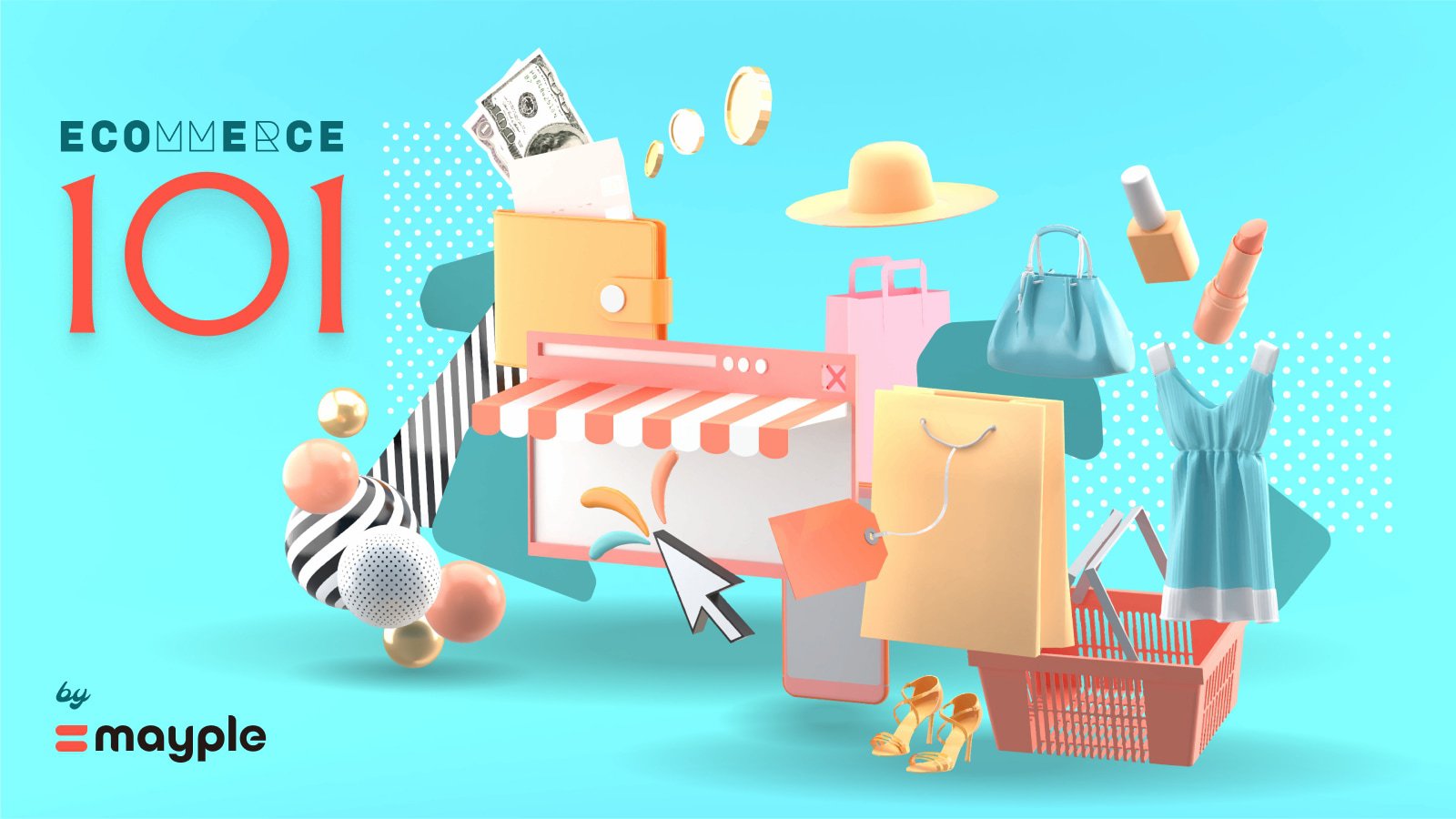
The eCommerce industry has seen the biggest spike in retail sales in its history. More traditional retailers are selling their goods online and more brick-and-mortar stores are jumping in.
Yet, a lot of experts are skeptical. There were a lot of shipping delays and the pendulum might be swinging in the other direction. Sales growth has slowed down from 17% to 9.7% and some experts believe that eCommerce needs to continue to evolve and solve those difficult fulfillment issues.
In this article, we define what is eCommerce, talk about the advantages and disadvantages, and present the latest trends you need jump on to scale your store.
Let’s dive in.
Key Takeaways
- Brands can sell products on their own eCommerce sites or on online marketplaces
- There are 5 main eCom models - DTC, white label, wholesaling, dropshipping, and subscription.
- The advantages of eCommerce are - greater access, better ROI, easier to offer a personalized omnichannel experience, better fulfillment, and improved retargeting
- The disadvantages of eCommerce are - customers can’t buy before they try, high expectations, shipping delays, and the industry is super competitive.
- The latest eCommerce trends - influencers, UGC, visual search, shop now pay later, DTC brands
What is eCommerce?
Ecommerce (stands for electronic commerce) is the process of buying and selling goods and services on the internet. It encompasses online marketplaces, eCommerce platforms, and a wide variety of data, systems, and tools for online buyers and sellers.
Businesses can sell their products online using an eCommerce store and/or sell on eCommerce platforms and marketplaces. Brands use a variety of e-Commerce marketing channels and tactics to grow their sales and deal with the operations side, such as logistics and fulfillment.
What’s the difference between an eCommerce platform and an online marketplace?
An eCommerce platform is a technology that is used by brands to build and host their online store. Examples of platforms include sites like Shopify, BigCommerce, WooCommerce, and Magento.
The eCommerce platform usually offers the brand services like web design, listing customization, SEO (which is often managed by eCommerce SEO agencies), payment encryption, mobile eCommerce, and other marketing plugins or tools.
An online marketplace is simply an online meeting place between sellers and buyers. They come with their own engaged audience and usually only offer the ability to display products and market them through advertising and promotions. They are places like Amazon, eBay, Houzz, Etsy, and Wish.
What is an eCommerce website?
An eCommerce website is simply a site that allows people to buy and sell physical goods and digital products. The sale happens on the internet instead of at a brick-and-mortar location.
By having an online store businesses can process orders, accept payments, manage shipping and logistics, an provide customer service all in one place. Brands that build their sites using platforms like Shopify or BigCommerce can use hundreds of plugins and marketing tools to improve every area of their business.
Understanding of how electronic commerce works
Still a little confused? Ecommerce works the same way a regular store does, except it all happens online. Here’s a brief summary of the process:
- Accept the order - the customer places an order on your site and you get an alert.
- Process the order - process the customer’s payment, similar to a store’s cash register, and sync the order with your various fulfillment systems.
- Ship the order - this is the last step of the process and it involves shipping the order to the customer. Ideally, you should shoot for a 2-day delivery if you want to really scale your business.
That’s the basic way eCommerce works, but there are different revenue models you should know about to really maximize your ROI.
5 eCommerce business revenue models
There are five main ways you could make money with an eCommerce business. Here are five revenue models you can choose from:
1. DTC
A new generation of consumer brands has been created by cutting out the middleman. The Direct-to-Consumer eCommerce model allows the brand to sell directly to its consumers, engage with its audience online, and increase sales rapidly. Instead of the average 10% margins, DTC brands can increase their margins to 30-50% using this model.
2. White label and private label
White labeling is when a brand partners up with a manufacturer or a distributor to create their physical product. That means the manufacturer produces the product and the brand can focus on technology and marketing.
3. Wholesaling
Wholesaling is when an online retailer offers their product in bulk at a discount. This model is traditionally used in B2B eCommerce transactions but some companies use this for price-conscious consumers.
4. Dropshipping
Dropshipping is when a brand sells a product that is fulfilled by a 3rd party supplier. Dropshipping platforms like AliExpress or Printful act as middlemen that connect brands to manufacturers. This model of eCommerce is a $95 billion market.
5. Subscription service
This is when a brand delivers its product or service at a regular time interval (weekly, monthly, annually, etc.). This is by far one of the most lucrative business models in the eCommerce world because it vastly improves lifetime customer value (CLV).
This model was used as early as the 1600s by English publishing companies to deliver books monthly to their customers. The SaaS eCommerce model took a lot of what worked in the 1900s and applied it to today’s internet users.
The different types of eCommerce
There are also different types of eCommerce business models that you should know about. And they depend on whether you’re selling your product to consumers, other businesses, or the government sector. Let’s look at each one in more detail.
1. Business-to-Business (B2B)
This is a transaction between two businesses, where one firm offers a good or service to another firm. For example, it could be a social media tool that sells access to social media scheduling features to small businesses. B2B is not consumer-facing and more and more B2B companies are slowly shifting to selling their products and services online.
2. Business-to-Consumer (B2C)
This is the most common type of eCommerce and it involves a business selling directly to the consumer. For example, if you buy a shirt from a fashion brand’s site you are engaging in a business-to-consumer transaction.
B2C has grown substantially over the last few years and it’s expected to grow by 85% in 2023 globally. In China alone, there will be an estimated 1 billion online shoppers by 2023. Nasdaq estimates that 95% of all shopping will be conducted online by 2040.
3. Business-to-Administration (B2A)
B2A (sometimes called B2G) is when a business sells its product or services to a government entity. For example, it could be a service company that provides a permitting service to a government administration, or a software company, or even a digital marketing agency.
4. Consumer-to-Business (C2B)
This is a traditional eCommerce transaction but in reverse. This is where a consumer sells a product or service to a business. One example of this could be when an influencer charges a business to take a picture or video with a product. This could also include a marketplace like Unsplash where people sell stock photos to different businesses.
5. Consumer-to-Consumer (C2C)
This is one of the earliest forms of e-commerce that involves a transaction between two consumers. A great example could be the sale of a used book by a consumer to another consumer on Amazon or eBay. Facebook Marketplace is solely dedicated to C2C transactions, where Facebook users trade and purchase products from eachother.
6. Consumer-to-Administration (C2A)
C2A refers to a transaction where a consumer offers a product or service to a government entity. This could be a tax filing or scheduling a health appointment online. And you’d be surprised, but government often use digital marketing consultants too.
7. Direct-to-Consumer (DTC)
DTC is similar to B2C but there’s an important distinction to make. DTC brands cut out the middle man and sell directly to the consumer. They are less likely to use other channels, big box stores, or even online marketplaces. They like to keep 100% control on their customer’s data and be able to personalize every touchpoint along the buyer’s journey.
History of eCommerce
It all began in 1979 when Michael Aldrich invented electronic shopping. He hooked up a modified TV to a transaction-processing computer via a telephone line. This technology made it possible to transmit payment data in a secure way and became the foundation for modern eCommerce.
The first ever eCommerce marketplace was called Books Stacks Unlimited and was launched in 1992. It later morphed into books.com. Then, in 1995, Jeff Bezos launched Amazon, which became the world’s largest online marketplace. It was initially started as an eCommerce platform for books.
PayPal was launched in 1998, which brought a new way to transfer money and purchase products and services online. Then came the large eCommerce platforms - Shopify in 2004, BigCommerce in 2009, and WooCommerce in 2011. Etsy launched in 2005 and became the world’s largest marketplace for handmade goods.
In 2014 we saw the world’s largest companies enter the arena with Walmart buying Jets.com in 2014 and Apple launching Apple Pay. Then, Instagram Shopping and Shoppable pins on Pinterest were launched, and there you have it. You can now easily design a store, accept payments, and get orders via social media and 100s of other channels online.
Want to learn more? Check out our awesome post on the history of eCommerce.
Growth of Ecommerce
E-commerce has grown at an unprecedented rate in the last few years. The arrival of platforms like Shopify and BigCommerce made it easier for brands to set up their online shops. Online payment gateways like PayPal, Google Pay, and Apple Pay plus payment processing tools like Stripe made it even easier to accept payments.
Experts even announced that the US lept 10 years forward in terms of eCommerce sales in the first 90 days when the epidemic hit.
See how the U.S. has leapt 10 years forward in 90 days’ time from physical channels to e-commerce. Also, how the acceleration in digital transformation by companies is widening the gap between leaders & laggards and more.
What’s interesting is that eCommerce sales were actually $57M more than what experts were predicting. The latest data suggests that by 2025 sales are going to be double what they were in 2017. US sales on Amazon increased by 19.1% in 2019 and amounted to over $222.6B, and global retail eCommerce sales are predicted to double to $7 trillion by 2024.
The advantages and disadvantages of eCommerce
But not everything is rosy in the world of eCommerce. There are definitely some powerful advantages involved in selling your goods online, but there are also a few disadvantages and hurdles you need to overcome to scale your business.
The advantages of eCommerce
Ecommerce is so popular because it has several key advantages that make it more desirable than the traditional brick-and-mortar model. Here are some of the most important ones.
Greater access
Ecommerce cuts out the middle man (supplier, distributor) and allows brands to have direct access to their customers. The brand can now communicate directly with the customer at every touchpoint. This spans email marketing (which is often managed by an eCommerce email marketing agency), SMS, chat messages, packaging inserts, social media, retargeting, referral programs, and much more.
DTC model improves the ROI and margins to 40-50%
When you cut out the middle man you also increase the margins. So eCommerce brands get to make more money by going DTC. This is why Adidas recently announced that they will be aiming for 50% of sales to be direct-to-consumer by 2025.
Brands are able to provide a true omnichannel experience
With eCommerce, you’re really able to create that omnichannel experience of attracting new leads and delighting customers through using multiple channels. And you can do that strategically and very effectively.
Flexibility and better fulfillment
Brands are able to be more flexible and offer a better customer experience when they sell online. They can speed up their fulfillment and service their customers better.
Faster response to buyer/market demands
When you sell directly to the customer you are able to be much more flexible and agile with your product offerings and features and can change things rapidly to better fit with market demands.
Ecommerce brands are not as reliant on long-term contracts with distributors and retailers that freeze up large amounts of inventory. So they can innovate at a much higher scale and rate.
Personalized online experience
One of the greatest advantages of running an eCommerce operation is the availability to personalize every aspect of the user experience. When a brand sells something on their own eCommerce site they have full control over every step of the customer’s journey, every design element, product listing, wording, and interaction with the customer.
Better retargeting and analytics
With eCommerce, brands have full control over their customer data. Brands can use the Facebook pixel to retarget everyone that comes to the site. They can also run Facebook advertising campaigns, native advertising on Google’s Display Network, or send email campaigns to specific audience segments.
Pro tip: want to scale your retargeting campaigns? Work with an expert eCommerce agency.
Brands can scale quickly
Ecommerce helps brands scale much faster than using a traditional commerce model. And this is true for brands that are already large. For example, L’Oreal’s eCommerce division is growing two times faster than the rest of the business.
Another example is the Canadian clothing brand Canada Goose. They set their eyes on growing their DTC efforts and were able to be 50% direct-to-consumer by 2019 with a 75.3% DTC gross margin.
The disadvantages of eCommerce
However, there are a few disadvantages to using the eCommerce model. Here are the main ones:
Customers can’t try before they buy
A major disadvantage of online shopping is that customers can’t try the product before they buy it. So some eCommerce brands are seeing increased return rates and this hurts industries like fashion and shoe retailers the most. That’s why brands are using augmented reality (AR) apps, like makeup apps that scan the user’s face and display different makeup products.
eCommerce is very competitive
There are fewer barriers to entry for eCommerce brands so there’s a lot more competition. It’s difficult to differentiate your product from the rest, to really build your store the right way, and sustain long-term growth. That’s why it’s important for every brand to conduct a thorough competitor analysis and build a comprehensive marketing plan.
Need help to grow your eCommerce store? Check out our guide on the latest strategies to
High consumer expectations
Online customers can expect better service and faster delivery times in the eCommerce industry. This can get challenging for brands as even one bad review can seriously impact sales. So the key here is to set the right expectations, communicate the brand story really well, and invest in a top-notch customer service team early on.
Unforeseen shipping delays
Online brands have a higher chance of something going wrong with a shipment. It could be the shipment to the customer or a bulk shipment to a warehouse.
Shipping delays occurred much more frequently during the COVID-19 pandemic and a lot of brands were incredibly affected by that. Supply chain management is a serious obstacle for eCommerce fulfillment operations worldwide.
Multiple devices per transaction
Ecommerce makes it harder to determine which channels to attribute a purchase to when a customer uses multiple devices to buy the product.
For example, a user might have heard about your product from a friend, and then gone on Google the brand in the evening and make the purchase. So the sale is going to show up under “organic search” when it should have been a “referral”.
That’s why brands should have a multi-touch attribution tracking setup and cross-domain tracking to really capture the right data.
An example of an eCommerce business
Let’s look at a few examples of eCommerce stores that are doing things right. Here’s Bite, a sustainable hygiene brand. They use a subscription-based model and their products are made in the US and 100% sustainable. They also have their customer reviews and UGC on every product page.
Another great example is Brightech, it’s an affordable lamp company. They sell floor lamps and string lights on a variety of marketing channels including online marketplaces (Amazon, Walmart), social media, influencers, and email marketing.
We’ve touched upon some of the things that make eCommerce stores successful, let’s look at the key components.
What makes a successful eCommerce store
There are a few key requirements for a successful eCommerce store.
- Good product - you need to have a good product, that actually solves a real pain point for the customer. Conduct market research to understand what customers want, and what price point you should set each product at.
- Compelling brand story - a brand story is absolutely essential for any brand. That could include your product story, your founding story, and the causes that you care about.
- Optimized site - a successful store needs to have an optimized checkout process and a site that converts well (that includes the product pages, category pages, and everything in between).
- Effective marketing channels - last but not least, you need a few channels that are monetized and bring in sales. Check out our list of eCommerce marketing strategies for some creative ideas.
Ecommerce Trends and the Future
Here are the top eCommerce trends to watch for 2024 and beyond.
DTC Brands
The biggest trend in eCommerce today is DTC. A lot more brands are focusing on developing that one-to-one relationship with their customers and really creating that personalized digital shopping experience.
Influencer marketing + UGC used as reviews and ads
Brands increasingly use influencers and user-generated content as reviews for social proof and as advertising creatives. Brands hire influencers to create short videos used for social media ads where influencers explain the product's benefits and show it in action.
Co-creating products with customers
Another future trend to follow is brands offering custom products to their customers. One great example of this is Nike by You where Nike lets their customers choose the colors and design of their show, creating a custom design.
Visual search
Another great feature that is quickly seizing the eCommerce world is the ability for a site user to search for a product by uploading an image of a similar product (like a reverse image search on Google).
Visual search lets the user search for a product using hundreds of tags and visual characteristics, which makes the entire customer experience so much easier.
Buy now pay later
There are more ways to make an online purchase today than ever before. There are digital wallets that let users pay by scanning their smartphones. There are also sites that offer Buy Now Pay Later options like AfterPay and Klarna that offer much more convenience for customers.
Recap
We’ve covered eCommerce from every angle and there is a lot more to talk about. An online store owner has a clear advantage over the average business owner with an incredibly varied arsenal of marketing strategies at their disposal.
Traditional retailers are focusing more and more on running their eCommerce programs and optimizing the eCommerce experience of their customers. If you want to learn about specific marketing strategies for eCommerce brands please check out our Ultimate Guide to eCommerce Marketing.
Interested in eCommerce solutions for your online business? Need help optimizing your marketing efforts? Talk to one of our eCommerce experts today. Our team of world-class friendly experts will help you grow your business like never before.
